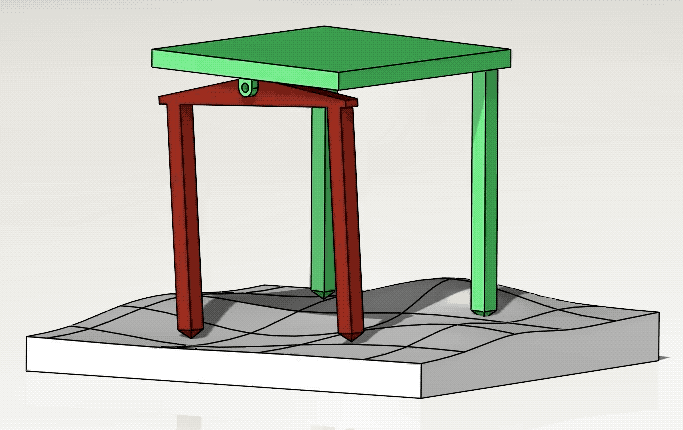| g e n u i n e i d e a s | ||||||
 |
 |
 |
 |
 |
 |
 |
| home | art and science |
writings | biography | food | inventions | search |
| wobble table |
|
May 2021 |
|
Wobbling Restaurant tables are the number one or two customer complaint industry wide- more than loud noises or bad service. Drinks spill, vases fall over, and deep conversations are rudely interrupted. The usual solution is an ad hoc wedge made from a folded napkin (or in the bad old days, a matchbook), stuffed under the "short" leg. But these wedges slip out when the table is even slightly displaced. Or, after a few minutes, the paper compresses and the wobble returns. Mathematicians offer a theoretical, but slightly impractical solution, based on applying the Intermediate Value Theorem (IVT) to this problem. Rotating the table around a vertical axis by less than 90 degrees can by shown to (almost always) pass through a position where all four legs touch down. More rigorous analysis confirms this argument is compelling, but is limited to tables with certain ratios of leg dimensions, and to floors which are uneven but not too irregular. Here is a simulation I created to illustrate the mathematical solution from a number of perspectives: But why is this mathematical "proof" impractical? Well, if you have to rotate the legs by 45 degrees it will bump into adjacent tables, or narrow the aisle between customers. Plus the dining room looks messy. Plus you have to readjust the chairs to line up with the table legs. In other words, rotation is fine for small tweaks, but not a universal remedy. Clever inventors have been drawn to this challenge and offer dozens of mechanical solutions. Some involve a network of hoses and pneumatic cylinders interconnecting each leg to automatically adjust their length to prevent wobble (e.g. the longer leg pumps liquid across to shorter leg until the wobbling ceases). Effective, but complex and expensive. You might imagine spring-loading each leg so they always touch the floor. The problem is the springs create a trampoline effect, and the table not only wobbles but oscillates. The solution is to complement each spring with an asymmetric shock absorber in each leg- the spring quickly extends the leg to fill any gaps, and if the table moves or you press your elbow down, the asymmetric shock absorber prevents the spring from quickly retracting. I prefer an alternate approach. Two legs (green) are fixed to the table top, and the other pair (red) are yoked together and attached to the table by a pivot. One leg of the yoke touches down first, and then rotates around the pivot until the second leg reaches the surface. Again, we can drag out the IVT as motivation for this approach, and again it will fail on particularly aberrant floors. More importantly, there is a region of instability on the table top (outside a triangle formed by the pivot and two green legs) where an elbow will cause the green legs to kick out. The remedy is a friction clutch on the pivot. In fact, there is a psychological need to assert control over life's small challenges, so having to press a button to momentarily release the clutch and settle the table in position, is actually an opportunity signal mastery over an uncertain world....
|
Contact Greg Blonder by email here - Modified Genuine Ideas, LLC. |
